A quick update tonight: check Michael's blog tomorrow and there will probably be a lot more detail and pictures.
First of all, we're safe. We live in a remote place on the coast, we live outside most of the time in a warm (non-friendly to flu) climate, there's no wheezing and hacking by our neighbors. We're probably living in as safe a place as we could be.
But there's definitely impact to the citizens of Mexico, regardless of the health issues.
At mid-day today, just as we were taking our friends Pat and Sanders Lamont out for a last lunch before they caught their plane back to the California from Manzanillo, the governor of Jalisco closed all the restaurants in the state.
No lie!
Everything was closed or closing in Melaque, we went on to Barre de Navidad -- ditto. We didn't realize that it had been mandated. We just thought the owners had decided to close.
When we got back to La Manzanilla late this afternoon, we found Palapa Joe's was closed. We figured there had to something pretty dramatic going on. Friends on the street told us what was up.
When we got back to Arroyo Seco, the police were just coming thru posting the declaration on the walls of the tiendas in town.
Our friends on the beach say they're pretty happy that the governor is getting in front of this thing, rather than waiting for the citizens of Jalisco to start spreading some virus.
But for the people of Mexico who have to work to feed their kids, there's a lot of disbelief and panic going on. Our friend Chena said she thinks we'll all soon be feeding the poorest of the poor who aren't able to work right now and won't be able to feed their children.
It's a little scary to watch a country shut down. It makes me worry for the economy of the country, and the global economy as well. But I'm willing to wait and see how this unfolds, hope that this virus will die a rapid death as the weather starts to turn hot.
What is also a little disheartening is how the U.S. and European news coverage of Mexico is confined to simply reporting on the number of sick, the number of deaths, and no reporting on actions and impacts, especially outside of Mexico City.
Just imagine living in a city the size of Puerto Vallarta --- almost 200,000 people --- and having all the restaurants, malls, theatres, bars and all other areas where people can gather closed down for more than a week.
In the meantime, it's a quiet, lovely night in the village. All is calm, for now. We'll try to keep you updated as we can.
Wednesday, April 29, 2009
Tuesday, April 28, 2009
News from Mexico
For all of you lovely friends that have been concerned about our health and welfare, thanks for caring --- and we're fine.
We've been reading about the swine flu and the possible pandemic. Veracruz and Mexico City seem to be Ground Zero for the virus. In Arroyo Seco, the only impact on our little village is that all the schools in Mexico have been closed for the next week or so, much to the chagrin of the parents.
The locals seem to be up on the news and on the threat. But it's all a watch and wait. We'll probably avoid the cities, wash our hands a lot and wait for the news, just as all of you are probably doing.
Otherwise, life is going on as usual. Michael is up watering all the plants and the grass. I'm getting ready to walk to the beach. We're meeting Sanders and Pat later in La Manzanilla for a beach afternoon and a nice dinner out. They fly home to Northern California tomorrow.
We'll update the blogs as we get information, but we feel pretty safe living in a tiny beach town where there aren't many people and everyone lives outdoors.
Apologies to all for not staying in touch through email. We've updated our wireless modem when the original one died and my old laptop no longer can connect through the wireless connection. So I have to trundle out to the 'comunications tent' to plug in to do my emails or hunt and peck on the iTouch.
We've been reading about the swine flu and the possible pandemic. Veracruz and Mexico City seem to be Ground Zero for the virus. In Arroyo Seco, the only impact on our little village is that all the schools in Mexico have been closed for the next week or so, much to the chagrin of the parents.
The locals seem to be up on the news and on the threat. But it's all a watch and wait. We'll probably avoid the cities, wash our hands a lot and wait for the news, just as all of you are probably doing.
Otherwise, life is going on as usual. Michael is up watering all the plants and the grass. I'm getting ready to walk to the beach. We're meeting Sanders and Pat later in La Manzanilla for a beach afternoon and a nice dinner out. They fly home to Northern California tomorrow.
We'll update the blogs as we get information, but we feel pretty safe living in a tiny beach town where there aren't many people and everyone lives outdoors.
Apologies to all for not staying in touch through email. We've updated our wireless modem when the original one died and my old laptop no longer can connect through the wireless connection. So I have to trundle out to the 'comunications tent' to plug in to do my emails or hunt and peck on the iTouch.
Saturday, April 25, 2009
The dog lady of Arroyo Seco
Helping out the dogs in the village has been a way to introduce myself to more of my neighbors, a way to get to know them on a daily level --- as much as one can with only a limited vocabulary and confined to present tense.
It's interesting that we don't seem to stick out here as much as I assumed we did. When I introduce myself, they sometimes tell me 'they've seen me around the village' or even thought I lived on the beach where a few other gringos live.
So, that's cool, I think.
We're a couple of Saturday's into our free clinics (free to the villagers but not to our wallet) and we're beginning to get a daily routine going.
I prepare a huge bowl of dog food, chicken scraps or other meat, rice cooked in chicken fat, grab a bottle of high-potency vitamins, all the various medications and Michael and I head out on the quad.
Right now we're committed to feeding our now-thriving Capitan and the blind 6-month old puppy, Paloma. Along the way, we run across other needy pooches and try to give them a healthy breakfast.
They are all extremely grateful.
Each dog seems to learn the sound of our Honda quad after one feeding, pretty amazing considering how many motos there are in the village.
Our tours remind me of stories I've read about the rural nurses making home visits in Appalachia. The families seem happy to have the help, invite us into their homes, give us small gifts of fruit or food to thank us for taking an interest. Last week Brianda gave Rocio, our vet friend, two baby ducks, something Rocio had been really wanting for her yard in La Manzanilla.
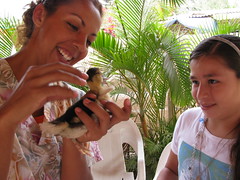
Brianda gives the vet, Rocio, two baby ducks to thank her for her help
The people here might also think we're a bit loco about the dogs, but that's okay too.
For now, my goal is three-fold: demonstrate how easy it is to have a healthy pet, get them medical help when they need it and the people can't afford it, and eventually slice and dice every dog's reproductive organ in Arroyo Seco.
Helping is easy, often frustrating too. One quick example:
Our surfing friend Julien, from France, saw a really tattered dog around the village who had lost most, but not all, of her hair. He grabbed the dog, had a friend trim the remaining straggly hair, then gave it a shot of medicine that pretty instantly cures the dog of the skin problem.
Within a month or two, I realized that the dog was an adorable cocker spaniel. Who knew? Unfortunately, the owner didn't get her spayed in time. Last week she had nine puppies, who will now need to get fed and cared for.
She's on my list for the next spay and neuter clinic, as are all nine of the puppies.
When we got back to Arroyo Seco last night after a leisurely day in La Manzanilla with our friends Sanders and Pat Lamont, Chon to help us give a couple of overdue injections to two dogs. One, Leona, is scheduled for surgery in our palapa tomorrow at noon. Rocio has been researching how to fix some female problem (she's already been spayed). Last night we had to put a muzzle on her and hold her down just to give her the mildest of injections. She loves to bite those who want to help.
I find working with her somewhat nerve-wracking. Leona is none too happy about it either.
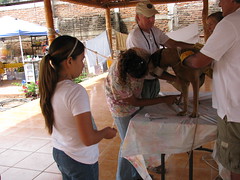
How many people does it take to treat Leona? A lot!
Samba, Julien's part-time dog, has adopted us and makes the rounds with us, I suspect because of the fragrant treats I carry with me. That's okay too. She's a poster child for what a healthy dog looks like. And great company too!
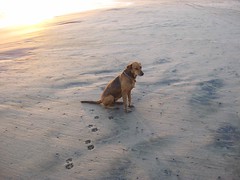
Samba makes house calls with us, then joins us for sunset at the beach
We also gave Capitan his last pills and one last shot, this one to boost his immune system. Now it's time to get the owner educated about how to keep him healthy. The biggest issue may be his pal, Paloma, who aggressively gobbles up all of the food before Capitan can get a bite.
We've learned to tie Paloma up near his own bowl until Capitan leisurely finishes his meal. It's a tradition we're hoping Marta understands as we pass the feeding chores back over to her.
The progress Capitan has made in the past few weeks is inspiring, we hope to our neighbors as well. He was probably just a few days from death when we got him. Eye infections, blood dripping from his nose, skin so raw that you couldn't touch it without it bleeding, barely able to walk or sit, too weak to stand to eat.
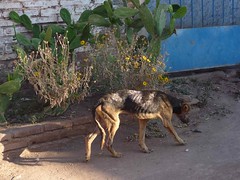
Capitan when we first spotted him in the village

Capitan after about two weeks of treatment and a lot of food
Now he's playful, growls and yips, wags his tail, takes walks to the village. He's already growing fine red hair where the skin had been scabbed and bleeding.
This week a family with three small children and two dogs are camped next to the jardin, the central garden across from the church, while they charge village kids to play on a big trampoline and a fooz ball game (or something similar) in the evening. For the past few days we've been feeding their mama-dog, who is nursing four puppies, and their ratty-haired fluffer-dog who drags its hind leg behind him. Broken? Twisted? We'll check it out on the next clinic, scheduled for tomorrow.
On our way to treat Leona, I spotted our friend Chena toweling off one of the toddlers from the same family camped at the jardin.
She said she saw how dirty the kids were and decided to help them out with a bath. Then she discovered the lice. So she had been de-lousing the three kids for the afternoon.
It seemed so symbiotic, that Michael and I would help out the pets, she would help out the kids, all part of healthy community that is willing to share what it has.
Nice.
My Spanish phrase for the week has been vale la pena --- worth the effort, worth the pain.
Here's a video that Michael posted on his blog about when Capitan came to visit last week. You can see the spring in his step already!
It's interesting that we don't seem to stick out here as much as I assumed we did. When I introduce myself, they sometimes tell me 'they've seen me around the village' or even thought I lived on the beach where a few other gringos live.
So, that's cool, I think.
We're a couple of Saturday's into our free clinics (free to the villagers but not to our wallet) and we're beginning to get a daily routine going.
I prepare a huge bowl of dog food, chicken scraps or other meat, rice cooked in chicken fat, grab a bottle of high-potency vitamins, all the various medications and Michael and I head out on the quad.
Right now we're committed to feeding our now-thriving Capitan and the blind 6-month old puppy, Paloma. Along the way, we run across other needy pooches and try to give them a healthy breakfast.
They are all extremely grateful.
Each dog seems to learn the sound of our Honda quad after one feeding, pretty amazing considering how many motos there are in the village.
Our tours remind me of stories I've read about the rural nurses making home visits in Appalachia. The families seem happy to have the help, invite us into their homes, give us small gifts of fruit or food to thank us for taking an interest. Last week Brianda gave Rocio, our vet friend, two baby ducks, something Rocio had been really wanting for her yard in La Manzanilla.

Brianda gives the vet, Rocio, two baby ducks to thank her for her help
The people here might also think we're a bit loco about the dogs, but that's okay too.
For now, my goal is three-fold: demonstrate how easy it is to have a healthy pet, get them medical help when they need it and the people can't afford it, and eventually slice and dice every dog's reproductive organ in Arroyo Seco.
Helping is easy, often frustrating too. One quick example:
Our surfing friend Julien, from France, saw a really tattered dog around the village who had lost most, but not all, of her hair. He grabbed the dog, had a friend trim the remaining straggly hair, then gave it a shot of medicine that pretty instantly cures the dog of the skin problem.
Within a month or two, I realized that the dog was an adorable cocker spaniel. Who knew? Unfortunately, the owner didn't get her spayed in time. Last week she had nine puppies, who will now need to get fed and cared for.
She's on my list for the next spay and neuter clinic, as are all nine of the puppies.
When we got back to Arroyo Seco last night after a leisurely day in La Manzanilla with our friends Sanders and Pat Lamont, Chon to help us give a couple of overdue injections to two dogs. One, Leona, is scheduled for surgery in our palapa tomorrow at noon. Rocio has been researching how to fix some female problem (she's already been spayed). Last night we had to put a muzzle on her and hold her down just to give her the mildest of injections. She loves to bite those who want to help.
I find working with her somewhat nerve-wracking. Leona is none too happy about it either.

How many people does it take to treat Leona? A lot!
Samba, Julien's part-time dog, has adopted us and makes the rounds with us, I suspect because of the fragrant treats I carry with me. That's okay too. She's a poster child for what a healthy dog looks like. And great company too!

Samba makes house calls with us, then joins us for sunset at the beach
We also gave Capitan his last pills and one last shot, this one to boost his immune system. Now it's time to get the owner educated about how to keep him healthy. The biggest issue may be his pal, Paloma, who aggressively gobbles up all of the food before Capitan can get a bite.
We've learned to tie Paloma up near his own bowl until Capitan leisurely finishes his meal. It's a tradition we're hoping Marta understands as we pass the feeding chores back over to her.
The progress Capitan has made in the past few weeks is inspiring, we hope to our neighbors as well. He was probably just a few days from death when we got him. Eye infections, blood dripping from his nose, skin so raw that you couldn't touch it without it bleeding, barely able to walk or sit, too weak to stand to eat.

Capitan when we first spotted him in the village

Capitan after about two weeks of treatment and a lot of food
Now he's playful, growls and yips, wags his tail, takes walks to the village. He's already growing fine red hair where the skin had been scabbed and bleeding.
This week a family with three small children and two dogs are camped next to the jardin, the central garden across from the church, while they charge village kids to play on a big trampoline and a fooz ball game (or something similar) in the evening. For the past few days we've been feeding their mama-dog, who is nursing four puppies, and their ratty-haired fluffer-dog who drags its hind leg behind him. Broken? Twisted? We'll check it out on the next clinic, scheduled for tomorrow.
On our way to treat Leona, I spotted our friend Chena toweling off one of the toddlers from the same family camped at the jardin.
She said she saw how dirty the kids were and decided to help them out with a bath. Then she discovered the lice. So she had been de-lousing the three kids for the afternoon.
It seemed so symbiotic, that Michael and I would help out the pets, she would help out the kids, all part of healthy community that is willing to share what it has.
Nice.
My Spanish phrase for the week has been vale la pena --- worth the effort, worth the pain.
Here's a video that Michael posted on his blog about when Capitan came to visit last week. You can see the spring in his step already!
Sunday, April 12, 2009
Living and learning in Arroyo Seco, Part II
It's been another week of firsts -- another week where I have had to learn a lot about living in a place with different customs, different values.
It's a big reason that we moved here (it wasn't just the temperate climate), but it also doesn't mean that it's always scripted out of a Disney movie.
Lesson Number 1
Actually, this is an ongoing lesson.
I love how most people around here can make something out of nothing, figure out how to fix, create, repair almost anything without having to drive to a Home Depot or an Ace Hardware or a WalMart. They are self-reliant and competent in a way that I remember from my childhood in the United States. People could actually do things, rather than hire people to do things.
But sometimes the cavalier approach is mind boggling, too. Last week the welder came to install our custom-made doors for our bathrooms. I guess he needed 220 power (or is it 210 here? I don't know....), so he took the front plate off the circuit breaker box and hot wired the dang thing.
Just wires.
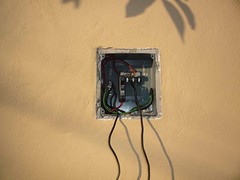
Hot-wiring the 220 power for the welder
When the concrete maestro was building the bathrooms, his son would hotwire a lamp to the wires where the outlets were going to go, but weren't installed yet. Same deal. Wires sticking into the electrical cord.
Seems scary to me, but I'm no electrician.
During the welding, no safety mask either. Unfortunately, he also didn't cover up the tile where he was working so the tile clean up is going to pretty intense next week. Hopefully those aren't burn marks I'm seeing....

No safety mask, no covering the brand new tiles either.
Lesson Number 2
Rocio, the vet from La Manzanilla, agreed to come out to Arroyo Seco Saturday morning and treat a few dogs at our place. We knew one dog that we had taken to Cisco's Amigo's last month to get spayed had a venereal cancer that needed to be treated and I had also spotted an emaciated dog out here that I was hoping to get checked out.
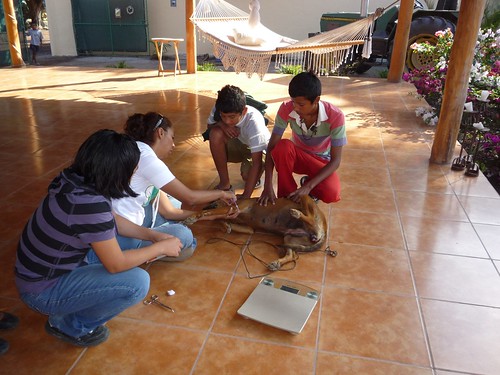
Rocio, the vet from La Manzanilla, makes a house call to Arroyo Seco
The first surprise was the message delivered by the son of the dog's owner --- who walked the dog down to our place --- that she just wanted the dog "to be put down."
This is a treatable disease, the dog is healthy otherwise, she's been their pet for three years. But the mom said she nips at some of the little kids and she's got to go.
My question to her, of course, is why today? And why did they get the dog neutered last month if that was the problem, or the plan?
Rocio handled it beautifully --- no doubt having some experience with this issue --- and told the boys she would treat the dog this time and we would talk to the mother next week (who wasn't home right then). And then I think I heard her tell them to make sure not to throw rocks at the dog, to pet the dog, to be nice, to feed it....
I was somewhat stunned. Being asked to put a relatively healthy dog to sleep wasn't exactly what I had in mind when I arranged to facilitate some help for some of my neighbor's dogs.
Next, some other boys dropped by the emaciated dog that I had asked about last week and invited them to bring the dog by for the vet to check out Saturday morning.
Same conversation. Just put the dog down, was the message from the boy's mother.
Again, not what I had in mind.
Rocio believes the dog can regain his health. He has anemia, probably parasites, a skin reaction from the fleas and other insects. But he has a healthy appetite and has a light in his eyes.
For a couple of hours that afternoon, it appeared that Michael and I had either adopted a tragically sick dog, or were going to be in the position of making the decision to execute a dog. And it happened so quickly, we didn't have the time to talk it out, consider what our position was.
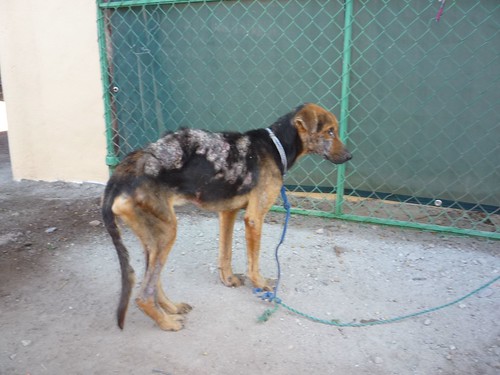
Poor ol' Capitan arrives at our house in Arroyo Seco for a visit with the vet
In the end, after a helpful conversation with my neighbor, Chena, and another conversation with the owner's daughter, we simply dropped the dog back at their house and told them we would be back with medicine and food four times a day for the next week and the vet would take another look at him then to see if he was strong enough to be treated for the anemia.
Luckily, the owner now seems grateful that we have taken an interest in Capitan and welcomes us when we arrive. The dog wags its tail when he sees her, he gets up to eat --- and eats a lot.
We asked Chena what the people in the village usually do when a dog is terrribly sick or there's a problem. She says if a dog gets bad enough, the owners drop them off at the nearby dump, thinking at least they will have a chance at feeding themselves. Or they will ignore it until the dog is a corpse in the backyard. Or, in rare instances, they will get out the 'pistola.'
So -- my lesson for this week is a vivid reminder, in both cases, that I'm living in a different world than my California/New York one. That people are much more cavalier, in many ways, about how they approach things. And that the people here aren't shopping at PetSmart and buying kibbles and bits for their pets.
I'm finding I can adjust, that no one was injured when they hotwired the welding machine, that maybe I can make difference with the dogs by focusing on getting them neutered so there are fewer cases of starvation and disease.
And maybe that's the most I can hope for. And it's OK.
It's a big reason that we moved here (it wasn't just the temperate climate), but it also doesn't mean that it's always scripted out of a Disney movie.
Lesson Number 1
Actually, this is an ongoing lesson.
I love how most people around here can make something out of nothing, figure out how to fix, create, repair almost anything without having to drive to a Home Depot or an Ace Hardware or a WalMart. They are self-reliant and competent in a way that I remember from my childhood in the United States. People could actually do things, rather than hire people to do things.
But sometimes the cavalier approach is mind boggling, too. Last week the welder came to install our custom-made doors for our bathrooms. I guess he needed 220 power (or is it 210 here? I don't know....), so he took the front plate off the circuit breaker box and hot wired the dang thing.
Just wires.

Hot-wiring the 220 power for the welder
When the concrete maestro was building the bathrooms, his son would hotwire a lamp to the wires where the outlets were going to go, but weren't installed yet. Same deal. Wires sticking into the electrical cord.
Seems scary to me, but I'm no electrician.
During the welding, no safety mask either. Unfortunately, he also didn't cover up the tile where he was working so the tile clean up is going to pretty intense next week. Hopefully those aren't burn marks I'm seeing....

No safety mask, no covering the brand new tiles either.
Lesson Number 2
Rocio, the vet from La Manzanilla, agreed to come out to Arroyo Seco Saturday morning and treat a few dogs at our place. We knew one dog that we had taken to Cisco's Amigo's last month to get spayed had a venereal cancer that needed to be treated and I had also spotted an emaciated dog out here that I was hoping to get checked out.

Rocio, the vet from La Manzanilla, makes a house call to Arroyo Seco
The first surprise was the message delivered by the son of the dog's owner --- who walked the dog down to our place --- that she just wanted the dog "to be put down."
This is a treatable disease, the dog is healthy otherwise, she's been their pet for three years. But the mom said she nips at some of the little kids and she's got to go.
My question to her, of course, is why today? And why did they get the dog neutered last month if that was the problem, or the plan?
Rocio handled it beautifully --- no doubt having some experience with this issue --- and told the boys she would treat the dog this time and we would talk to the mother next week (who wasn't home right then). And then I think I heard her tell them to make sure not to throw rocks at the dog, to pet the dog, to be nice, to feed it....
I was somewhat stunned. Being asked to put a relatively healthy dog to sleep wasn't exactly what I had in mind when I arranged to facilitate some help for some of my neighbor's dogs.
Next, some other boys dropped by the emaciated dog that I had asked about last week and invited them to bring the dog by for the vet to check out Saturday morning.
Same conversation. Just put the dog down, was the message from the boy's mother.
Again, not what I had in mind.
Rocio believes the dog can regain his health. He has anemia, probably parasites, a skin reaction from the fleas and other insects. But he has a healthy appetite and has a light in his eyes.
For a couple of hours that afternoon, it appeared that Michael and I had either adopted a tragically sick dog, or were going to be in the position of making the decision to execute a dog. And it happened so quickly, we didn't have the time to talk it out, consider what our position was.

Poor ol' Capitan arrives at our house in Arroyo Seco for a visit with the vet
In the end, after a helpful conversation with my neighbor, Chena, and another conversation with the owner's daughter, we simply dropped the dog back at their house and told them we would be back with medicine and food four times a day for the next week and the vet would take another look at him then to see if he was strong enough to be treated for the anemia.
Luckily, the owner now seems grateful that we have taken an interest in Capitan and welcomes us when we arrive. The dog wags its tail when he sees her, he gets up to eat --- and eats a lot.
We asked Chena what the people in the village usually do when a dog is terrribly sick or there's a problem. She says if a dog gets bad enough, the owners drop them off at the nearby dump, thinking at least they will have a chance at feeding themselves. Or they will ignore it until the dog is a corpse in the backyard. Or, in rare instances, they will get out the 'pistola.'
So -- my lesson for this week is a vivid reminder, in both cases, that I'm living in a different world than my California/New York one. That people are much more cavalier, in many ways, about how they approach things. And that the people here aren't shopping at PetSmart and buying kibbles and bits for their pets.
I'm finding I can adjust, that no one was injured when they hotwired the welding machine, that maybe I can make difference with the dogs by focusing on getting them neutered so there are fewer cases of starvation and disease.
And maybe that's the most I can hope for. And it's OK.
Friday, April 10, 2009
Arroyo Seco dogs take a road trip to La Manzanilla
This is the story of how a couple of dozen dogs from Arroyo Seco came to be hurtling down the highway in the back of our truck to a surgical unit in a neighboring town 30 minutes south of here.
Cisco's Amigos is a hugely successful volunteer (as in free!) animal clinic in La Manzanilla, founded by Julie Wagner and Rusty Schuetz from Nevada City, California (now permanent La Manzanilla residents). Apparently when they arrived in La Manzanilla years ago, they saw what we still see in many villages --- dogs with skin problems, emaciated dogs, dogs with too many puppies and just not enough food. A lot of sick dogs.
It's not that the Mexicans don't love their dogs. They do. But they frequently don't have the means to take care of them as most of us do in the states. And the animals often face many more challenges from living in a sandy (ok, dusty), hot, sub-tropical climate.
So Julie --- a woman after my own heart --- decided to do something about it, one dog and one cat at a time. The first, obvious step was to get the animals neutered. The females were having litter after litter with not enough food, not enough care.
It's made an astounding difference in La Manzanilla. It is the rare animal that suffers in the village and now there's someone to call. There's also a new, fantastic veterinarian in town as well. So the animals in La Manz are generally a lot healthier.
Cisco's has expanded over the past few years, allowing dogs from outlying areas to be transported in on specific clinic days. Last year our friend Tia Richardson picked up a load of stray dogs from Tenacatita. They came in, had a quick snip-snip of their reproductive organs, then got deposited back on their 'home' beach.
One afternoon at Palapa Joe's this past December, Julie and I enthusiastically agreed to have a remote clinic at Arroyo Seco on March 24, one of the clinic days scheduled for La Manzanilla. I was encouraged to produce 30 dogs to make it worth their while to move the volunteer vets and the clinic to our new palapa.
So I talked to friends and neighbors and two tienda owners took names and created a list of animals (strays and family dogs) for the clinic. There was a lot of excitement!
Then --- drum roll --- it became apparent that it would be too difficult to move the clinic out here this year but that we could have a designated Arroyo Seco clinic day in La Manzanilla.
Uh-oh!
So there we were on Arroyo Seco clinic day, a half-hour away by car, packing up the back of my truck and three others with all the animals that needed to go to the clinic but whose owners didn't have the means to transport them.
We called in the night before our clinic day to confirm with Julie and her amigos that we would be bringing in 21 dogs, mas or menos, and Julie said the vets enthusiastically said 'bring em on!'
It was a long day for everyone!
We started loading up the trucks at 7 a.m. We went rolling around the village to pick up each critter, tying them up in the back of the truck or tossing them in the back of the Isuzu Trooper, the smaller ones in some of the few cages we had.
We descended on Cisco's Amigos much to the shock and awe of the volunteers who were already close to overwhelmed for the day before we even arrived with our troupe. The clinic treated probably a record-breaking 57 animals by late that night. We left after 7 p.m. with the last dog, a Great Dane that was moved --- still asleep --- from the operating table to the back of our SUV, driven by Michael. He said he watched the rear view mirror the entire trip, hoping that the Dane would be friendly if he awoke from the anesthesia.
No matter how chaotic this all sounds, it was a great, important, incredible day for all of us in Arroyo Seco.
The people here were so grateful to have some help with their animals.
The dogs bounced back from the surgery the minute they got home and realized that they weren't on some train to a medical testing facility. They leaped and bounced and barked and licked when they saw their families, their familiar surroundings.
I've gotten to know a lot of people by going to their homes to meet their dogs.
Dogs I assumed were ferocious are as sweet as puppies and they are friendly to me when we take our evening walk. I'm beginning to learn their names.
I also learned that I don't have to be a trained vet to treat some of the simple problems I see in some of the animals here. A skin problem. Getting the right vaccinations. And there are others in the Rancho who also want to help.
In the end, it wasn't about a gringa --- an American -- coming in and wanting to fix and change a village. It was just someone in the rancho who knew how participate in a clinic and how to help with something they wanted. I had a ton of help from everyone who lives here.
Getting 20-some animals neutered this year in this small a village is HUGE. I'm guessing that if we can have a monthly clinic, a few dogs each time, we could really get a handle on the health and the size of the dog population within a year.
So that's the new goal.
Tomorrow we have a vet coming to our palapa to treat a village dog with a sexually-transmitted cancer and we'll start looking what other dogs need medical care.
We've arranged for one of our teens, Chena's daughter Brianda, to start an apprenticeship with the vet in La Manz.
It's all exciting, easy, rewarding.
And, really, it's all thanks to Julie at Cisco's Amigo's, for having the vision in the first place to see that this is a solvable issue and within our means to help.
For those of you in the states (or anywhere) who would like to help:
Cisco's remains a volunteer organization, it just 'depends on the kindness of strangers.' They have a few fundraisers during the year and collection cans around the village. If you'd like to contribute, please contact me and I'll make sure they get the money. This is one organization that uses every single peso towards its cause.
Just email me at fitzfox AT gmail.com.
Labels:
Arroyo Seco,
Cisco's Amigos,
Julie Wagner,
La Manzanilla,
Mexico,
Rusty Wagner
Sunday, April 5, 2009
A day of rest in our new & improved Arroyo Seco home
 Today we took a necessary day of rest after almost a week of putting in sod and plants around our Pink Flamingo property in Arroyo Seco. We were on serious dust control duty, trying to get a handle on how much dust we breathe, how much dust lands on our palapa floor and in our outdoor kitchen.
Today we took a necessary day of rest after almost a week of putting in sod and plants around our Pink Flamingo property in Arroyo Seco. We were on serious dust control duty, trying to get a handle on how much dust we breathe, how much dust lands on our palapa floor and in our outdoor kitchen.The results are pretty spectacular!
We've gone from a dust bowl to a lush jardin --- a green, grassy
 area that will keep us cool and clean. Many of our new neighbors have been stopping by to see what we've done. A friend reminded us that it wasn't that many years ago the owner was grazing cattle here.
area that will keep us cool and clean. Many of our new neighbors have been stopping by to see what we've done. A friend reminded us that it wasn't that many years ago the owner was grazing cattle here.Today I felt my mother's gene's kick in as I puttered around the property, planting various flowers in front of the bathrooms, moving ferns around in front of the old grey goose trailer, deciding where to put the frog pot with the beautiful lily we just planted.
My mother was a master gardener at her place in upstate New York. Her joy was to spend the day in the dirt and her home still reveals her ability to plan a garden that was meant to last for years. As difficult a relationship as we had, the sweetest moments came the last few years of her life when she would sit in a chair in the driveway and direct me to prune the flowers, explain which plants were weeds, why I should allow some of the wisteria to creep into her garden. She was pleased that I finally cared, that she could share this thing that she loved with me.
She would have loved it here!
The people of Arroyo Seco are all gardeners, for the most part. The soil is rich river bottom. Bougainvilla will sprout from a stick, as will most of the sub-tropical plants. It's what makes this village stand out from many others --- the burst of color surrounding most homes.
 While grass is a novelty (no worries, everyone. It's low maintenance crab grass and if we don't buy a mower, we'll at least invite the neighborhood goats in for a scheduled maintenance), a jardin is something our neighbors can all relate to.
While grass is a novelty (no worries, everyone. It's low maintenance crab grass and if we don't buy a mower, we'll at least invite the neighborhood goats in for a scheduled maintenance), a jardin is something our neighbors can all relate to.Today was Palm Sunday. A friend stopped by with his grandson (and his donkey) after the church service to check out the new jardin.
Tomorrow we paint the bathrooms in anticipation of the new bathroom doors, which are scheduled to arrive from the welder on Tuesday.
A new member of the Singing Headlamps?
Michael brought his ukulele to practice a few tunes with Sasha, our 7-month old granddaughter living in Puerto Vallarta with her parents, Dustin and Camelia.
Here's their debut video:
Here's their debut video:
Subscribe to:
Posts (Atom)